|
The TrophyCatch Season 7 Hall of Fame Ceremony took place in October at Bass Pro Shops Gainesville! It was an exciting event with 10 of our 11 winners able to attend to be recognized in person. Each one caught, documented and released a bass weighing 13 lbs. or more. Brian Hammett was crowned the TrophyCatch Season 7 Champion, for his amazing 15 lbs. 13 oz. fish from Orange Lake which was the biggest approved bass of the year. Each winner received an amazingly lifelike replica mount by New Wave Taxidermy, a commemorative plaque from The American Registry, and an Enigma Fishing rod to catch more trophy bass with! Several Hall of Fame veterans from previous years were also present to round out a cast of amazing anglers and their incredible catches.
|
|
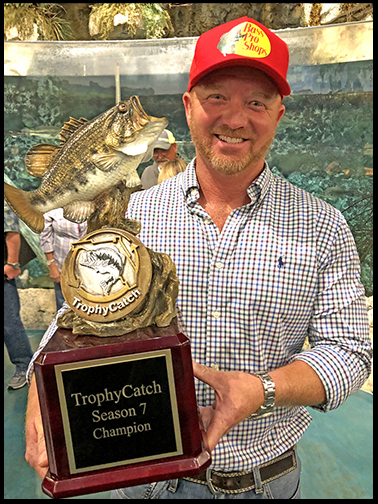 |
Here are the TrophyCatch Season 7 Hall of Fame anglers with their replica mounts. James Wirtz (on far left) actually caught-and-released 2 Hall of Fame bass this season!
|
One Hall of Fame angler, Tony Russ, was also awarded the Lake Big Bass Big Bag Prize! This prize package is bestowed on the angler with the heaviest combined weight for their top 5 TrophyCatch submissions. Tony's total bag weight was 61 lbs. 6 oz., an average of over 12 lbs. per fish! The great prize package provided by Lake County includes a 2-night stay at the beautiful Mission Inn Resort and an amazing day fishing with Lake Big Bass Professional Angler, Tim Fredericks, FLW Tour Champion!
Watch for the next issue of the newsletter which will have the results of the Phoenix TrophyCatch bass boat drawing!
|
|
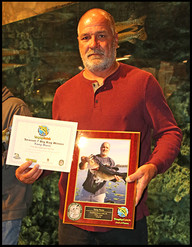 |
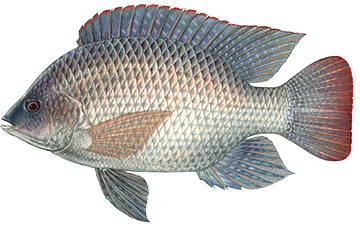
Size: The blue tilapia is one of our largest exotic fish. The state record is 9.38 pounds. The Big Catch minimum size for recognition is 5.00 lbs. or 18 inches.
Identification and similar species: The broken lateral line distinguish this fish as a cichlid. Adults are blue-gray shading to white on the belly; juveniles may possess dark spots on the body. The borders of the dorsal and caudal fins may have red to pink edges. Mozambique tilapia and Nile tilapia are similar, but usually have distinct vertical striping on the caudal fin (tail). Possible hybridization between these species further complicates identification.
Angling qualities: Tilapia are not known for their sporting quality, but do fight well on rod-and-reel. Tilapia can be caught using small pieces of hot dogs, bread balls, dog food, or live worms for bait. They are rarely caught on artificial lures. They can be harvested by cast net (where allowed) and are popular bowfishing targets. As an illegally-introduced exotic there are no bag or size limits. Tilapia have white, flaky meat with a mild flavor and are considered excellent eating. Tilapia are commonly available in grocery stores and restaurants.
Where to find them: The blue tilapia may be Florida's most widespread exotic fish. It is abundant throughout most of the state, and can be found in lakes, ponds, rivers, streams, and canals. It is tolerant of saltwater and found in some near shore marine habitats, such as Tampa Bay; see the article below about fresh and saltwater fish species.
Interesting facts: Even when you don't actually see them, you can often tell that blue tilapia are present by their very large beds along the shoreline. Males dig circular nests more than 2 feet across in shallow water over a sandy bottom. The male swims out to a passing female and leads her to the nest where courtship and egg-laying occur. The female takes the eggs into her mouth, where they are protected until they hatch. The fry are occasionally released to feed, but whenever threatened they return to the female's mouth for protection until they are about three weeks old. This type of parental care is called mouth-brooding.
Fish illustration by Diane Rome Peebles.
|
 |
|
Did you know? The Big Catch angler recognition program helps you celebrate memorable-sized catches of 33 freshwater species! A qualifying submission nets you a personalized certificated suitable for framing and hanging. |
One of the broadest generalizations used to group fish is whether a given species occurs in freshwater or saltwater. When anglers draw this distinction, they are thinking of what fish species will be available for them to catch where they’ve decided to go fishing. When biologists compare the two, however, their thoughts will run to fish biology and fish excretory (or waste elimination) systems.
One of the most basic biological principles is that different substances dissolved in a solution tend to move from an area of higher concentration to one of lower concentration, until the distribution is even. Put a few drops of blue food coloring into a glass of water without stirring it, and eventually the water will be one color (instead of clear in one part and blue in the other). This process is called diffusion.
A substance in solution will eventually become evenly distributed throughout the solution through the process of diffusion.
Since all fishes actually live in a solution — water — the same basic principle is extremely important to them. In freshwater, the concentration of salts and minerals important for life is much higher in the fish’s own body than it is in the surrounding water. These salts tend to move from the fish’s body (high concentration of salts) to the surrounding water (low concentration of salts). Similarly, the nearby water itself has a tendency to move from the surrounding environment (high concentration of water) into the fish’s body (lower concentration of water). As a result, the excretory system of a freshwater fish must get rid of excess water that enters the fish, while at the same time keeping important salts from escaping from the fish’s body into the watery environment. A freshwater fish’s urine is very dilute, containing excess water that the fish must rid its body of, but few of the salts that the fish needs to retain.
 |
For a freshwater fish, water tends to enter the body while salts tend to leave.
A saltwater fish has just the opposite problem! The concentration of salts in the saltwater around it is higher than within its own body, and excess minerals tend to travel into the fish’s body. At the same time, pure water itself is at a higher concentration within the fish’s body than outside it, and the fish must keep this water from leaving its body. A saltwater fish’s excretory system works to rid the body of excess salts, while simultaneously preventing the loss of water. The urine of saltwater fishes therefore contains high concentrations of minerals, but low amounts of water.
For a saltwater fish, salts tend to enter the body while water tends to leave.
Some species of fish can tolerate a very wide range of salinities (salt concentrations) in the surrounding water. Their excretory systems are highly adaptable, and are actually able to adjust to freshwater or saltwater conditions; fishes with this ability are called euryhaline (say YOUR-EEE-HAY-LINE). Blue tilapia (a freshwater species; see above) can live in saltwater, while snook and tarpon (saltwater species) can live in freshwater. This adaptability is just one factor contributing to the diversity of fishing available in our Florida fresh and salt waters!
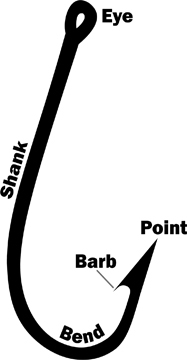
No matter how good a rod you’re using, no matter what brand of line is on the reel, no matter what you paid for that lure, it all meets the fish at only one point—the hook. Knowing the right kind of hook to use, selecting the correct size, and keeping it sharp will . . . put more fish on the hook!
The parts of a hook (left) are relatively simple, and will apply to nearly all kinds. There are many different kinds of hooks available, but don’t let yourself be overwhelmed—a few basic hooks will meet most of your needs. When choosing hook size, go smaller rather than larger when in doubt . . . many large fish have been caught on small hooks! Note that the numbering of hook sizes increases as the hook gets smaller (the bigger the number, the smaller the hook!). The exception is when the numbering gets down to 1 for larger hook sizes (1/0 or greater), in which case the hook size increases as the number does (1/0, 2/0, 3/0, etc.).
The Aberdeen is an excellent all-around choice for light freshwater bait fishing. The fine wire minimizes damage to the bait, and reduces interference with its natural movement. The long shank also makes hook removal easier even if the fish has partially swallowed the bait. This hook is designed to bend and pull loose under heavy pressure if it becomes caught on a solid object such as submerged brush. For this reason, don’t use too heavy a line with an Aberdeen—if there’s a big fish on the other end instead of a stump, you want the drag to slip before the hook straightens! Good sizes include 8-10 for bream, 4-6 for crappie, and 2-6 for light-line bass or catfish angling.
|
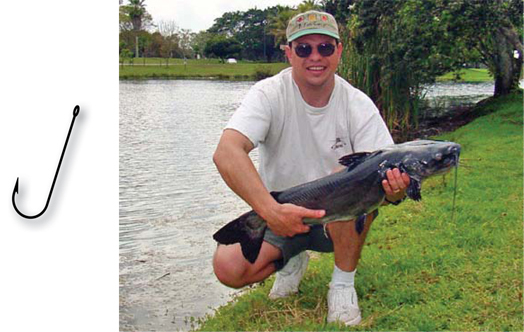 |
A small #6 Aberdeen hook was used to land the 12-pound catfish that surprised the angler above. The fish was originally stocked by FWC.
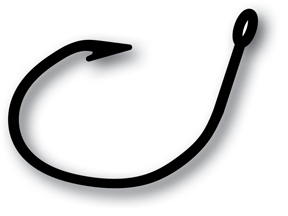
For heavier bait fishing, many savvy anglers have turned to the popular circle hook. Although not a new design (it’s been in use by commercial anglers for years), the circle hook has more recently been popularized as a valuable tool for recreational fishermen too. This unusual-looking hook is designed to minimize gut-hooking, instead catching the fish near the corner of the mouth almost every time. Not only that, but anglers experience a significantly higher percentage of successful hookups too—circle hooks reduce the number of missed strikes. Instead of setting the hook when you get a strike as you do with conventional hooks, you should simply apply increasing pressure and the fish will basically hook itself. Circle hooks are especially helpful for unusually difficult hooking situations, such as bait fishing for tough-mouthed larger bass or tarpon.
|
Worm hooks for weedless rigging of plastic baits come in a variety of styles. These hooks usually have a distinct elbow bend in the shank near the eye, where the following part of the hook will emerge from the plastic bait. These are available in straight or offset shank styles. In order to rig a “straight” worm that will not twist unnaturally when retrieved, lay the hook on top of the worm and note where it should emerge from and re-enter the body. By rigging the worm this way, you should be able to avoid making the worm kink. Sizes used generally range from 1 to 5/0, depending on the size of the plastic bait. Wide gap versions have become increasingly popular for plastic baits.
 |
Getting to the point: Modern hooks come out of the package much sharper than their ancestors did! If you are using a name brand hook, you may not need to sharpen it at all, or only touch up the point if it gets dulled. For freshwater hooks, a small whetstone works better than a metal file, which tends to remove too much metal too quickly. Sharpen the hook on each side first, and then finish up by sharpening the point opposite the barb. If the hook hone has a “point groove,” then the final step is that much easier. The traditional test of hook sharpness, seeing if it “sticks” when you touch the point to your thumbnail, still works.

To barb or not to barb: Although more and more hook styles are becoming available barbless, most of the time it’s still up to the angler to provide this option for himself if he wants it. Barbless hooks have the advantages of penetrating a fish’s mouth more readily and being easier to remove (from fish, shirt, or fishin’ buddy!), in addition to reducing the level of hooking injury likely to occur to the fish itself. Especially for beginning anglers, quick hook removal from fish or self is a major convenience. De-barbing is probably most important for bait fishing, where the chances of a fish swallowing the hook are higher. However, many anglers de-barb all their lure hooks, too. Regardless of whether you fish simply for the sport, or strictly for the frying pan, the FWC encourages anglers to use barbless hooks so that those fish that are released have a better chance of survival.
So remember . . . a good rod-and-reel combo and decent line can help you catch fish, but you’ll want to have a good hook too!
|
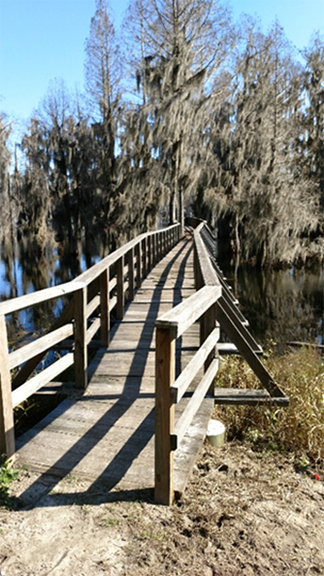
Size: 63 acres.
Location: Suwannee County.
Description: Suwannee Lake is a secluded, 63-acre hidden gem located in Live Oak. Anglers can enjoy good fishing from a pier, along the bank, or by boat. Built by the then-Florida Game and Freshwater Fish Commission in 1967, Suwannee Lake had a long-standing reputation of being a good trophy bass fishery. Over time, however, habitat disappeared and forage fish soon followed. Without an abundant food supply the bass started to die off. Those that were present remained small, and the lake lost its public appeal. This loss prompted FWC staff to restore what was lost, and restoration plans commenced in 2011. The work to bring back the fishery included dewatering, muck removal, redesigning the lake’s topography, refilling the lake, stocking fish, planting vegetation, pier construction, and more. The lake re-opened to the public in 2016.
Two years after the lake reopened, an intensive survey was conducted to assess the bass population. The post-restoration bass population was nearly double that of the pre-restoration population. Bass were also larger on average, and 8 trophy bass were sampled during the survey. For more details on the project see the post at the Bassmaster website.
Bass are now well-distributed across the entire lake and they move quite a bit. Where you catch them one day, may yield very little the next. Locations to target bass within the lake are abundant: numerous standing cypress trees on the north side, along the drop-off from the pier, amongst the pads in the south end, along vegetation that encircles the lake, near the underwater ridge or any of the other added features/fish attractors whose locations are mapped out on the sign at the boat ramp.
Work shiners (Carolina rigged) around cypress trees and woody debris, at drop-offs, or along the edges of vegetation. Heavier line is recommended around standing timber. In spring, weedless soft plastics or live baits such as shiners fished near shore where vegetation is dense should produce strikes. When the hot weather arrives, fishing early or late will be more productive. Try using a heavier line with shiners when fishing amongst the cypress trees. White spinner baits retrieved close to standing timber in mid-depth areas is also a productive method. Later in the season, use shallow-running crankbaits with squared-off lips, as the wobble action produced by this style lip allows for better deflection off submerged stumps. Buzz baits and imitation frogs have been very productive in the fall.
|
 |
FWC began a major restoration project on Suwannee Lake in 2011, and the lake was reopened to the public in 2016.
To contact the Florida Freshwater Angler, email John Cimbaro.
|